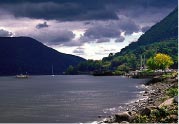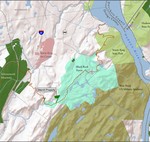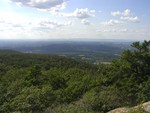 |
| May 17, 2025 |
Welcome! Click here to Login
|
 |
|
|


|
|
|
Click to visit the
Official Town Site
|
|
|
|
|
|
General News: Open Space Institute Purchases 32 Acres

|
| The 32-acre Merrill property is highlighted in dark green on this map. |

|
| A view from Black Rock Forest of the recently protected 32 acres. |
February 24, 2011
Another chunk of open space has been protected in Cornwall, where 32 acres that abut the south-western tip of Black Rock Forest have been purchased by the Open Space Institute.
Two adjacent properties formerly owned by the Merrill family will extend the reach of the forest and help protect the mile-and-a-half corridor that connects Black Rock Forest and Schunnemunk Forest State Park. The area provides a roaming ground for wildlife traveling between the two parks that is home to native flora and fauna such as bears, bobcats, coyotes and otters, chestnut-oak forests and pitch pines.
“These properties are both part of the Black Rock Forest ecosystem,” said Bill Schuster, executive director of the nonprofit Black Rock Forest Consortium, , “and they contain sensitive streams and wetlands. Protecting these properties will preserve the water quality of Woodbury Creek as well as habitat in this important corridor.”
Last September, the Open Space Insitute acquired a 151-acre parcel along Route 32 in Cornwall that formerly belonged to Houghton farm. The two purchases will also help protect the 125-mile Highland Trail, which runs from the Hudson River near Bear Mountain through the Highlands of New Jersey and on to the Delaware River. Traversing Storm King State Park, Black Rock Forest, Schunnemunk Mountain State Park and numerous other public parks, watershed areas and wildlife management areas, the trail had been threatened by increasing development on the western escarpment of the Black Rock Forest Preserve.
“These acquisitions, although small in acreage, will have dramatic effects by preserving recreational access in the region for many thousands of people, while protecting habitat for plants and animals. This region of New York is one of the state’s most ecologically diverse, and therefore important to permanently protect,” said OSI CEO Kim Elliman.
Comments:
No comments have been posted.
Add a Comment:
Please signup or login to add a comment.
|
 |
|
|
|